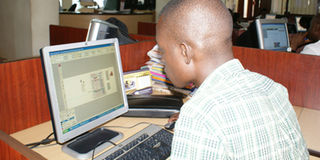Prime
Uganda’s journey to a computerised era

RIGHT DIRECTION: Much as there are still hurdles to jump, Uganda is on the right path to a computerised society. PHOTO BY ISAAC KASAMANI
What you need to know:
About one million Ugandans have access to computers, a number which is still lacking compared to the developed countries. For instance about 120 million people in the US, according to statistics from US Census Bureau have access to a computer.
In the past decade, there has been a tremendous increase in the use of information technology with new applications coming on the market: Skype technology has one making calls using a computer connected to the Internet and teleconferencing which allows meetings between people in different places with a click of the mouse.
What drove this transformation where the laptop and palm top are increasingly becoming items of common usage, and where is it heading?
The beginning
The first computer ever in Uganda was an unwieldy mainframe, which arrived in 1967. According to Dr Ham-Mukasa Mulira, an IT expert, Independence resulted in a rise in government workers so the computer was brought in to help with management of public servant’s payroll.
The mainframe was a huge, heavy metallic box-like object with neither a keyboard, mouse, nor a central processing unit. Instead, it functioned through punch cards, usually operated by women, and it required special skills to operate. It could only be used for adding and subtracting numbers.
It was stationed at the Uganda Computer Services in the Ministry of Finance under the supervision of Mr I.K Kabanda, the then government chief statistician who also spearheaded the training of Uganda’s first computer specialists.
In 1968, the second mainframe arrived and was taken to Makerere University’s department of mathematics and placed under Prof. Paul Mugambi, currently vice chancellor of Nkumba University. It was a preserve for those who were doing mathematics, today’s computer scientists. Later, this was sold to Dr Patrick Mangheni of Uganda Data Services, making him the first Ugandan to offer computer services commercially.
It was not until the mid 80’s that the first desktop Apple was brought to Uganda. I was purchased by Makerere University at the prompting of the then bursar, Mr Khan, to handle the university’s payroll.
The boom
Hardly 50 years since the mainframe’s arrival, there are now hundreds of thousands of computers in the country.
According to Mr Blasio Kigozi, Uganda’s first systems analyst, now in private business; “if the current development is not politicised, IT development in Uganda is headed for good things”.
Now not only IT professionals use computers, but the everyday person, especially in the urbanised part of the country. The noisy type-writers have been replaced by soft touch and sensor key boards, and work which used to take two days during the era of the mainframe, now takes less than an hour to complete.
Productivity levels have definitely moved up with this development. Almost all the nearly 30 universities across the country offer an ICT component on their programme prospectus which means the critical mass required to service the growth is being built in tandem with the increased access. The increase in computer usage and ownership has been boosted by the scrapping of tax on computers. A computer that used to cost about Shs1.6m now goes for as low as Shs500,000.
About one million Ugandans have access to computers, a number which is still lacking compared to the developed countries. For instance about 120 million people in the US, according to statistics from US Census Bureau have access to a computer.
The hurdles
However, last year the government banned the importation of used computers to increase the use of new computers and protect the environment, something which has caused consternation, even amongst government ministers.
A government official, who preferred anonymity in order not to be seen as opposing the wider government policy, told Saturday Monitor that computer usage is most likely to be adversely affected if the ban on used computers is maintained.
“(Few people) in Uganda can afford a brand new computer... I know we take decisions as a team but if used computers are banned then we might take longer to realise what we would have otherwise achieved if they were allowed in the country,” he said.
“If they [government] think computers are dangerous to environment why don’t they ban television sets, because they are even more dangerous than computers?” he asked.Coupled with the ban on the importation of used computers, Uganda’s IT sector faces other challenges.
Mr Asuman Jombwe, a private IT consultant, says although there has been tremendous development in IT professionalism, thanks to the increase in IT programmes offered at tertiary institutions, the two biggest problems affecting progress is the naivety in computer usage by the end-users and the poor infrastructure.
“Most of these people do not know how to use a computer, or the importance of IT. They think IT is only about being able to know the basics of a computer, and this has heavily affected the IT market because if there’s a big number of informed users, then there’s a big market, hence a high demand for IT,” he said.
He added; “IT infrastructure is only based in Kampala and some urban centres. In some towns it’s limited to Internet kiosks. If the government wants to increase the impact of IT on the people, it has to improve on the country infrastructure.”
In defence
But the Principal Information Scientist and Spokesperson in the Ministry of ICT, Mr Geoffrey Kiirya, defends the concentration of ICT in urban centres.
“Computers have to use power and although the government is trying to enforce rural electrification it has not fully reached most places so we cannot have computers there,” said Mr Kiirya. He says ICT development in Uganda is on the same footing like in any other country in the world but the difference is in the difficulty to access the new technologies.
“We are developing at a steadfast speed and any technological development happening in any part of the world can come here any time. It’s is only the cost of these new technologies that prevent us from acquiring them but we are conversant as a country on what development takes place.”
Such enthusiasm is not shared though with Mr Kigozi insisting that: “We are a bit backward. We need very well-trained people. The institutions of learning,
especially Makerere University, should do much more to help develop the field”.
But developments are happening. According to Mr Kiirya, the most important new technology in Uganda is the national backbone fibre cable being installed by Huawei, a Chinese company, to provide Uganda with quicker Internet access.
“This technology aims at easing accessibility to Internet and technological services. It will save the people from the satellite services which are slow and expensive,” he said.
The benefits could be immense. Mr Kiirya affirms that with improved Internet services, the government could roll out telemedicine practices in hospitals and also tertiary institons will be linked.
With what has been achieved so far, Uganda is on the right path to computerisation.




